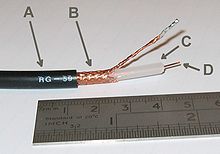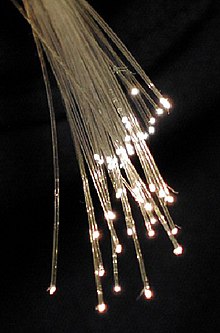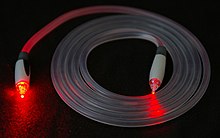Transmission medium

A transmission medium is a system or substance that can mediate the
Optical medium
Telecommunications
A physical medium in data communications is the transmission path over which a signal propagates. Many different types of transmission media are used as
In many cases, communication is in the form of electromagnetic waves. With guided transmission media, the waves are guided along a physical path; examples of guided media include phone lines, twisted pair cables, coaxial cables, and optical fibers. Unguided transmission media are methods that allow the transmission of data without the use of physical means to define the path it takes. Examples of this include microwave, radio or infrared. Unguided media provide a means for transmitting electromagnetic waves but do not guide them; examples are propagation through air, vacuum and seawater.
The term direct link is used to refer to the transmission path between two devices in which signals propagate directly from transmitters to receivers with no intermediate devices, other than amplifiers or repeaters used to increase signal strength. This term can apply to both guided and unguided media.
Simplex versus duplex
A
In simplex transmission, signals are transmitted in only one direction; one station is a transmitter and the other is the receiver. In the half-duplex operation, both stations may transmit, but only one at a time. In full-duplex operation, both stations may transmit simultaneously. In the latter case, the medium is carrying signals in both directions at the same time.
Types
In general, a transmission medium can be classified as
- linear, if different waves at any particular point in the medium can be superposed;
- bounded, if it is finite in extent, otherwise unbounded;
- uniform or homogeneous, if its physical properties are unchanged at different points;
- isotropic, if its physical properties are the same in different directions.
There are two main types of transmission media:
- guided media—waves are guided along a solid medium such as a transmission line;
- unguided media—reception are achieved by means of an antenna.
One of the most common physical media used in networking is
Guided media
Twisted pair
Twisted pair cabling is a type of wiring in which two conductors of a single
Coaxial cable

- Outer plastic sheath
- Woven copper shield
- Inner dielectric insulator
- Copper core
Coaxial cable, or coax (pronounced /ˈkoʊ.æks/) is a type of electrical cable that has an inner conductor surrounded by a tubular insulating layer, surrounded by a tubular conducting shield. Many coaxial cables also have an insulating outer sheath or jacket. The term coaxial comes from the inner conductor and the outer shield sharing a geometric axis. Coaxial cable was invented by English physicist, engineer, and mathematician Oliver Heaviside, who patented the design in 1880.[3]
Coaxial cable is a type of
because the dimensions of the cable and connectors are controlled to give a precise, constant conductor spacing, which is needed for it to function efficiently as a transmission line.Optical fiber




Optical fiber, which has emerged as the most commonly used transmission medium for long-distance communications, is a thin strand of glass that guides light along its length. Four major factors favor optical fiber over copper: data rates, distance, installation, and costs. Optical fiber can carry huge amounts of data compared to copper. It can be run for hundreds of miles without the need for signal repeaters, in turn, reducing maintenance costs and improving the reliability of the communication system because repeaters are a common source of network failures. Glass is lighter than copper allowing for less need for specialized heavy-lifting equipment when installing long-distance optical fiber. Optical fiber for indoor applications cost approximately a dollar a foot, the same as copper.[4]
Multimode and single mode are two types of commonly used optical fiber. Multimode fiber uses LEDs as the light source and can carry signals over shorter distances, about 2 kilometers. Single mode can carry signals over distances of tens of miles.
An optical fiber is a flexible,
Optical fibers typically include a
Being able to join optical fibers with low loss is important in fiber optic communication.[11] This is more complex than joining electrical wire or cable and involves careful cleaving of the fibers, precise alignment of the fiber cores, and the coupling of these aligned cores. For applications that demand a permanent connection a fusion splice is common. In this technique, an electric arc is used to melt the ends of the fibers together. Another common technique is a mechanical splice, where the ends of the fibers are held in contact by mechanical force. Temporary or semi-permanent connections are made by means of specialized optical fiber connectors.[12]
The field of applied science and engineering concerned with the design and application of optical fibers is known as fiber optics. The term was coined by Indian physicist Narinder Singh Kapany, who is widely acknowledged as the father of fiber optics.[13]
Unguided media
Radio
Radio propagation is the behavior of
Different types of propagation are used in practical radio transmission systems.
At lower frequencies in the MF, LF, and VLF bands, due to diffraction radio waves can bend over obstacles like hills, and travel beyond the horizon as surface waves which follow the contour of the Earth. These are called ground waves. AM broadcasting stations use ground waves to cover their listening areas. As the frequency gets lower, the attenuation with distance decreases, so very low frequency (VLF) and extremely low frequency (ELF) ground waves can be used to communicate worldwide. VLF and ELF waves can penetrate significant distances through water and earth, and these frequencies are used for mine communication and military communication with submerged submarines.
At
In addition, there are several less common radio propagation mechanisms, such as
Digital encoding
Transmission and reception of data is typically performed in four steps:[16]
- At the transmitting end, the data is encoded to a binary representation.
- A carrier signal is modulated as specified by the binary representation.
- At the receiving end, the carrier signal is demodulated into a binary representation.
- The data is decoded from the binary representation.
See also
References
- ISBN 978-0470483367.
- ISBN 9780782143317.
- ISBN 0-8018-6909-9.
- ISBN 978-0470483367.
- ^ "Optical Fiber". www.thefoa.org. The Fiber Optic Association. Archived from the original on 24 January 2009. Retrieved 17 April 2015.
- ISBN 978-0130326812.
- ^ "Birth of Fiberscopes". www.olympus-global.com. Olympus Corporation. Archived from the original on 9 May 2015. Retrieved 17 April 2015.
- .
- ^ Senior, pp. 12–14
- ^ The Optical Industry & Systems Purchasing Directory. Optical Publishing Company. 1984.
- ^ Senior, p. 218
- ^ Senior, pp. 234–235
- ^ "Narinder Singh Kapany Chair in Opto-electronics". ucsc.edu. Archived from the original on 2017-05-21. Retrieved 2019-05-06.
- ISBN 0-672-20678-1, Library of Congress Card No. 43-14665 page 26-1
- ISBN 0-07-048470-8, Chapter 8
- ISBN 978-0470483367.
